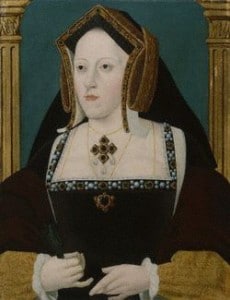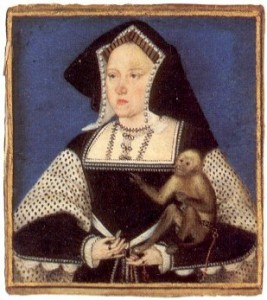 If you have read my review of Giles Tremlett’s book “Catherine of Aragon: Henry’s Spanish Queen”, you will notice that I mention Tremlett’s theory regarding Catherine of Aragon’s alleged eating disorder. Well, Tremlett has written an article for the Daily Mail – “Was Henry Vlll’s first wife anorexic? Catherine of Aragon’s secret problem” – in which he explores this theory further and even theorises that her “disordered eating” could have led to fertility problems which prevented her from producing the much needed male heir.
If you have read my review of Giles Tremlett’s book “Catherine of Aragon: Henry’s Spanish Queen”, you will notice that I mention Tremlett’s theory regarding Catherine of Aragon’s alleged eating disorder. Well, Tremlett has written an article for the Daily Mail – “Was Henry Vlll’s first wife anorexic? Catherine of Aragon’s secret problem” – in which he explores this theory further and even theorises that her “disordered eating” could have led to fertility problems which prevented her from producing the much needed male heir.
Did Catherine of Aragon Have an Eating Disorder?
I agree with Giles Tremlett that Catherine of Aragon probably did have some kind of eating disorder. Tremlett quotes “one intimate observer” in 1510 as saying, “Irregularity in her eating and the food which she takes makes her unwell which is why she does not menstruate well”1 and, after being told of Catherine’s zeal for fasting and abstinence, by the Prince of Wales (the future Henry VIII), Pope Julius sent a missive saying that if “the devotions and fasting of the wife” were “thought to stand in the way of her physical health and the procreation of children” then they could be “revoked and annulled by men.”2
Did Catherine’s Eating Disorder Affect Her Fertility?
Tremlett goes on to describe how Catherine’s fasting adversely affected her menstrual cycle and how “in her early twenties… she went more than nine weeks without menstruating.”3 However, although Catherine’s religious fervour and fasting may have had such a knock-on effect, as a woman I also know how worry and stress can also cause a woman’s menstrual cycle to be irregular.
Catherine was, as Tremlett describes, “a political bargaining chip”, a pawn on the chessboard of Europe, and she was left in dire straits after the death of Prince Arthur. Catherine suddenly went from being secure, both financially and politically, as the future queen of England, to being in a very precarious situation. Nobody wanted her, she was in limbo. She got herself into debt, she was a foreigner in a country where she couldn’t speak the language, her father was arguing with the King, her future was uncertain and she felt abandoned by everyone; it really is no wonder that she became depressed and ill and I am sure that this affected her menstrual cycle.

Did Catherine’s Eating Disorder Prevent Her from Giving Henry VIII a Son?
I’m not sure that we can blame the lack of a male heir on Catherine’s fasting or a possible eating disorder because I don’t see any evidence of Catherine having any trouble getting pregnant.
In my article “The Pregnancies of Anne Boleyn and Catherine of Aragon”, I quote historian J. J. Scarisbrick4 as saying that Catherine of Aragon had “several miscarriages, three infants who were either stillborn or died immediately after birth (two of them males), two infants who died within a few weeks of birth (one of them a boy) and one girl, Princess Mary” and if we take “several” to mean three or more then we can assume that she had at least nine pregnancies. Hester Chapman5 credits her with having seven pregnancies, John Bowle6 says six, A.F. Pollard7 says around ten and Neville Williams8 writes of how Henry VIII was “mindful of earlier miscarriages” in his second year of marriage to Catherine. When we consider that by November 1509, just 5 months after her wedding to Henry VIII, Catherine was pregnant and that even today, 500 years later, couples are told not to worry about their fertility until they have been trying for a baby for at least one year, then I can’t see that Catherine had any type of fertility problem.
In his article “The Alleged Miscarriages of Catherine of Aragon and Anne Boleyn”9, Sir John Dewhurst writes that the primary sources only give evidence for six pregnancies:-
- 31st January 1510 – The stillbirth of a daughter.
- 1st January 1511 – A son, Henry, who died 52 days later.
- 17th September 1513 – Birth of a son who was either stillborn or who died in very early infancy.
- November 1514 – Another son who was either stillborn or who died soon after birth.
- 18th February 1516 – Birth of Princess Mary, the future Mary I.
- 10th November 1518 – The stillbirth of a daughter.
So, at least six pregnancies in 8 years, surely we can’t believe that Catherine had fertility problems.
Giles Tremlett concedes that Catherine did have at least six pregnancies and that miscarriages and infant deaths were common in Tudor times, but he writes that “research also suggests that both miscarriages and underweight babies can be linked to eating disorders” – is this true?
Are Eating Disorders linked to Miscarriages and Stillbirths?
From my initial research into this, I have to agree with Mr Tremlett. In an article “Pregnancy and Eating Disorders”, on Bulimia.com, Diane Mickley, MD, says:-
“The outcome of pregnancy may be compromised in women with active eating disorders, those with subtle eating disorders, and even those who are fully recovered… Complications commonly reported in studies of pregnancy in women with past or active eating disorders include higher rates of miscarriage, morning sickness, preterm delivery, and cesarean section. Fetal complications include intrauterine growth retardation, babies who are premature or small for gestational age, and newborns with low birth weights, smaller head circumferences, and /or low Apgar scores.”10
This is backed up by an article “Eating Disorders in Pregnancy” on Epigee.org, which says:-
“During pregnancy… the effects of an eating disorder can be even more serious, affecting the growth and development of your baby… Having an eating disorder during pregnancy puts your baby at a high risk of developing a number of medical disorders. Your baby can also die from improper nutrition or stress caused by your eating disorder… The most common problems seen in pregnant women with eating disorders is an increased risk of low birth weight babies and preterm labor. Both bulimics and anorexics often fail to take in adequate nutrition and some refuse to gain weight, causing their babies to be underweight, underdeveloped, and malnourished. Mothers with eating disorders are more likely to give birth to babies with respiratory illnesses and low Apgar scores. Babies of malnourished moms also have a 35% increase in the risk of coronary death and are 6 times more likely to develop diabetes later in life.
A lack of adequate calories and nutrition can also cause developmental problems for your baby. Babies of women with eating disorders are at increased risk for developing cerebral palsy, liver disorders, cleft palate, blindness, and other physical abnormalities. They are also at increased risk for mental disorders, including lowered IQ, learning disabilities, and mood disorders later on in life.
Eating disorders during pregnancy can also lead to the death of your baby. Mothers who do not eat right and gain insufficient amounts of weight can suffer from spontaneous abortions or stillbirth.”11
I also found out that eating disorders can lead to early menopause12 so perhaps Catherine’s lack of pregnancies after 1518, when she turned 33, were down to her going through an early menopause or a temporary menopause caused by irregular eating.
Conclusion
It may be, then, that Catherine’s religious fervour, her fasting and her irregular eating led to her having problems carrying babies to term, having healthy babies and going through the menopause early. It’s not that her alleged eating disorder prevented pregnancies, more that it affected the outcome of her pregnancies, and that it accelerated the menopause, causing her to stop menstruating in her mid 30s.
Of course, her miscarriages and the deaths of her babies may have been completely unrelated to her fasting and we can’t say, definitively, that Catherine of Aragon had an eating disorder, but she was certainly a sickly woman who had to cope with a lot of stress in her life. Giles Tremlett’s theories regarding Catherine’s eating, her health and her obstetric history certainly make interesting reading.
Anorexia Mirabilis
We think of eating disorders like anorexia nervosa being a modern phenomena but if you look up “anorexia” on wikipedia it gives you the option of anorexia nervosa or anorexia mirabilis which “refers almost exclusively to women and girls of the Middle Ages who would starve themselves, sometimes to the point of death, in the name of God.”13 Wikipedia goes on to say that anorexia mirabilis “was frequently coupled with other ascetic practices, such as lifelong virginity, flagellant behavior, the donning of hairshirts, sleeping on beds of thorns, and other assorted self-mutilations. It was largely a practice of Catholic women, who were often known as ‘miraculous maids'” and that such women “notoriously refused all food except for the holy Eucharist, signifying not only their devotion to God and Jesus, but also demonstrating, to them, the separation of body and spirit.” Catherine of Aragon was an extremely devout Catholic who, later in her life, wore a hair shirt and was ready to die as a martyr, so I think that Catherine may well have had anorexia mirabilis.
What do you think?
Did Catherine have an eating disorder? Did it affect her fertility?
Notes and Sources
Catherine of Aragon: Henry’s Spanish QueenGiles Tremlett, p114
- Ibid., p115
- Ibid.
- Henry VIII, J.J. Scarisbrick, p150
- Anne Boleyn, Hester Chapman, p41-42
- Henry VIII, John Bowle, p159
- Henry VIII and His Court, Neville Williams, p47
- Henry VIII, A.F. Pollard, p12
- The Alleged Miscarriages of Catherine of Aragon and Anne Boleyn, Sir John Dewhurst.
- Pregnancy and Eating Disorders, Diane Mickley, MD
- Eating Disorders in Pregnancy, Epigee.org
- Premature Menopause in Girls – It CAN Happen
- Wikipedia page on Anorexia Mirabilis